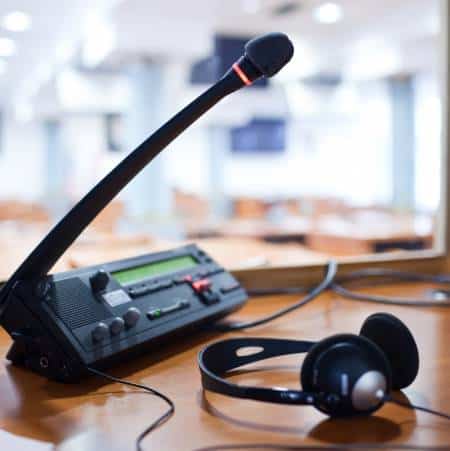The symphony of languages is a fascinating arena that can be daunting for the uninitiated. Simultaneous interpretation is an art that requires profound linguistic skills, cultural fluency, and razor-sharp concentration. As complex as it may seem, mastering this art is within reach with the proper understanding, techniques, and a knack for juggling different languages.
Understanding Simultaneous Interpretation: A Quick Overview
Simultaneous interpretation is a complex and dynamic form of language translation in real time. Unlike consecutive interpretation, where the speaker pauses to allow translation, simultaneous interpreters work concurrently with the speaker, delivering the translated message almost instantly. This demanding task requires exceptional linguistic skills, a deep understanding of diverse subjects, and quick thinking.
Simultaneous interpreters use specialized equipment, such as headsets and microphones, to communicate the translated content to the audience in settings such as:
· Conferences
· Meetings
· Important Events
They must maintain accuracy, fluency, and clarity, ensuring that the essence of the message is preserved while adapting it to the target language.
The role of a simultaneous interpreter goes beyond language proficiency; it involves cultural sensitivity, adaptability, and the ability to handle high-pressure situations. As language ambassadors, these professionals play a crucial role in facilitating effective communication across linguistic barriers, contributing to the success of international gatherings and events.
The Significance of Cultural Fluency in Interpretation
Being an interpreter goes beyond being bilingual - it means becoming a cultural diplomat. The deep intertwining of language and culture forms a unique tapestry that defines every civilization. Hence, grasping cultural nuances is as crucial to simultaneous interpretation as linguistic skills.
For instance, idiomatic expressions, deeply rooted in cultural contexts, can often lose meaning when translated verbatim. A good interpreter must find a way to convey the essence of such phrases in the target language. Similarly, understanding cultural touchpoints, societal norms, historical references, and social etiquette is integral to delivering an accurate and relatable translation.
Consider colloquialisms, which are often region-specific and can be challenging to translate. An interpreter attuned to the language's culture can discern these linguistic subtleties and deliver a faithful interpretation. The goal is to make the audience understand the words and, feelings and sentiments behind them.
To master this aspect of the craft, interpreters must immerse themselves in the cultures of the languages they work with. This involves studying the literature, consuming the media, interacting with the people, and even visiting the places, if possible. The aim is to grasp the spirit of the culture, to 'live' the language.
In simultaneous interpretation, the interpreter isn't just a linguistic conduit but a cultural ambassador. They can foster understanding and bridge cultural gaps in real-time through their work. Consequently, interpreters are responsible for wielding their cultural knowledge with sensitivity and precision, ensuring the true essence of the message is conveyed, regardless of cultural boundaries. Thus, cultural fluency's role in interpretation must be balanced.
The Role of Memory and Concentration Skills
Memory and concentration skills are the lifelines that keep the high-wire act of simultaneous interpretation steady and successful. Can you imagine translating spoken words in real-time while maintaining the message's rhythm, intent, and essence? It's like trying to piece together a complex puzzle at breakneck speed.
The role of memory in this challenging act is twofold: short-term memory is used to hold onto the words just long enough to translate them, while long-term memory acts as a vast library of linguistic structures, technical terminologies, and cultural references.
But memory is only part of the equation. Concentration is the rudder that steers this dynamic process. Maintaining an iron-clad focus amidst the rapid-fire exchange of words, the interpreter has to parse meaning, detect cultural nuances, and formulate an accurate translation - all in the blink of an eye. This requires a laser-like focus that can block out distractions and keep pace with the ever-evolving narrative.
It's like being a skilled musician in an orchestra, where the notes of the symphony are words and phrases. Just as a musician must remember their part while listening and adapting to the other instruments, an interpreter must remember the speaker's words while listening for new information and translating it simultaneously. The complexity of this process highlights the importance of sharp memory and unwavering concentration.
Remember, this isn't a memory game or a concentration test in isolation. These two crucial skills work together, like a pianist's right and left hands, each performing a unique function yet working in harmony to produce a beautiful melody - or, in this case, a successful interpretation.
Hiring Simultaneous Impetration
In the dynamic landscape of global interactions, our interpreters are not just linguists; they are architects of understanding. Imagine hosting events where language barriers dissolve, fostering an environment where ideas, negotiations, and collaborations flow effortlessly across diverse linguistic realms.
Their expert team ensures that your message retains its precision and cultural nuances, creating an atmosphere where communication is elevated to an art form. Choose the synergy of simultaneous interpretation to amplify the impact of your international engagements. Break free from linguistic constraints and embrace a world where every word is a bridge to cross-cultural unity.


No comments yet